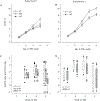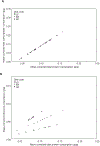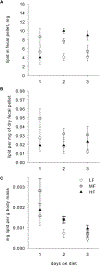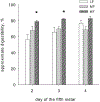Effects of high-fat diet on feeding and performance in the tobacco hornworm, Manduca sexta
- PMID: 31302290
- PMCID: PMC6785999
- DOI: 10.1016/j.cbpa.2019.110526
Effects of high-fat diet on feeding and performance in the tobacco hornworm, Manduca sexta
Abstract
Nutritionally balanced diets are important for overall fitness. For insects, fat is vital for development due to its high-energy value. Little is known about how insects regulate dietary fat for storage, but research has shown conflicting results on how altering fat impacts development and performance. In this study, we sought to investigate how high-fat diets affect developing insects. To determine how insects respond to variation in dietary fat content, we reared Manduca sexta of different larval stages on diets containing varying concentrations of linseed oil in high (5.6%), medium (3.4%) or low (0.4%) fat. Young larvae reared on high-fat diets had 80% mortality and 43% lower body mass compared to those reared on medium- or low-fat diets. Older larvae showed no difference in mortality with increasing dietary fat content, but they were smaller than controls, suggesting a developmental shift in lipid metabolism. We measured mRNA expression of Apolipoprotein I and II (APO1 and 2), proteins responsible for transporting lipids, as a possible explanation of increased survival in older larvae. Levels of APO1 and 2 mRNA did not differ with dietary fat content. We then tested the hypothesis that the high-fat diet altered feeding, resulting in the observed decrease in body size. Caterpillars fed a high-fat diet indeed ate less, as indicated by a decrease in food consumption and the number and mass of fecal pellets produced. These results suggest that increased fat disrupted feeding and may indicate that there is a threshold for lipid storage, but further studies are needed to understand the underlying mechanism.
Keywords: Anorexia; Development; Fat body; Growth; High-fat diet; Insect; Juvenile; Lipid content; Nutrition.
Copyright © 2019 Elsevier Inc. All rights reserved.
Figures








Similar articles
-
Nutrition interacts with parasitism to influence growth and physiology of the insect Manduca sexta L.J Exp Biol. 2005 Feb;208(Pt 4):611-23. doi: 10.1242/jeb.01404. J Exp Biol. 2005. PMID: 15695754
-
Feeding behaviour and nutrient selection in an insect Manduca sexta L. and alterations induced by parasitism.J Comp Physiol A Neuroethol Sens Neural Behav Physiol. 2005 Oct;191(10):909-23. doi: 10.1007/s00359-005-0013-5. Epub 2005 Sep 29. J Comp Physiol A Neuroethol Sens Neural Behav Physiol. 2005. PMID: 16133504
-
The influence of larval diet on adult feeding behaviour in the tobacco hornworm moth, Manduca sexta.J Insect Physiol. 2007 Sep;53(9):923-32. doi: 10.1016/j.jinsphys.2007.03.007. Epub 2007 Mar 18. J Insect Physiol. 2007. PMID: 17467729
-
Developmental expression of mRNAs for epidermal and fat body proteins and hormonally regulated transcription factors in the tobacco hornworm, Manduca sexta.J Insect Physiol. 2010 Oct;56(10):1390-5. doi: 10.1016/j.jinsphys.2010.03.029. Epub 2010 Apr 7. J Insect Physiol. 2010. PMID: 20361974 Review.
-
How insects protect themselves against combined starvation and pathogen challenges, and the implications for reductionism.Comp Biochem Physiol B Biochem Mol Biol. 2021 Aug-Sep;255:110564. doi: 10.1016/j.cbpb.2021.110564. Epub 2021 Jan 27. Comp Biochem Physiol B Biochem Mol Biol. 2021. PMID: 33508422 Review.
Cited by
-
Does Larval Rearing Diet Lead to Premating Isolation in Spodoptera litura (Fabricius) (Lepidoptera: Noctuidae)?Insects. 2021 Feb 27;12(3):203. doi: 10.3390/insects12030203. Insects. 2021. PMID: 33673724 Free PMC article.
-
The effect of diet composition on the diversity of active gut bacteria and on the growth of Spodoptera exigua (Lepidoptera: Noctuidae).J Insect Sci. 2024 Mar 1;24(2):13. doi: 10.1093/jisesa/ieae031. J Insect Sci. 2024. PMID: 38513149 Free PMC article.
-
What You Eat Matters: Nutrient Inputs Alter the Metabolism and Neuropeptide Expression in Egyptian Cotton Leaf Worm, Spodoptera littoralis (Lepidoptera: Noctuidae).Front Physiol. 2021 Nov 4;12:773688. doi: 10.3389/fphys.2021.773688. eCollection 2021. Front Physiol. 2021. PMID: 34803746 Free PMC article.
-
Mismatched menu: the incompatibility of adult black soldier flies as praying mantis feed.Front Insect Sci. 2025 Mar 19;5:1531683. doi: 10.3389/finsc.2025.1531683. eCollection 2025. Front Insect Sci. 2025. PMID: 40177289 Free PMC article.
-
Determining the scale at which variation in a single gene changes population yields.Elife. 2020 Feb 14;9:e53517. doi: 10.7554/eLife.53517. Elife. 2020. PMID: 32057293 Free PMC article.
References
-
- Adamo SA, 2005. Parasitic suppression of feeding in the tobacco hornworm, Manduca sexta: Parallels with feeding depression after an immune challenge. Archives of Insect Biochemistry and Physiology 60, 185–197. - PubMed
-
- Adamo SA, Bartlett A, Le J, Spencer N, Sullivan K, 2010. Illness-induced anorexia may reduce trade-offs between digestion and immune function. Animal Behaviour 79, 3–10.
-
- Adamo SA, Fidler TL, Forestell CA, 2007. Illness-induced anorexia and its possible function in the caterpillar, Manduca sexta. Brain Behav Immun 21, 292–300. - PubMed
-
- Ayuba VO, Ojobe TO, Ayuba SA, 2011. Phytochemical and proximate composition of Datura innoxia leaf, seed, stem, pod and root
Publication types
MeSH terms
Substances
Grants and funding
LinkOut - more resources
Full Text Sources
Research Materials

